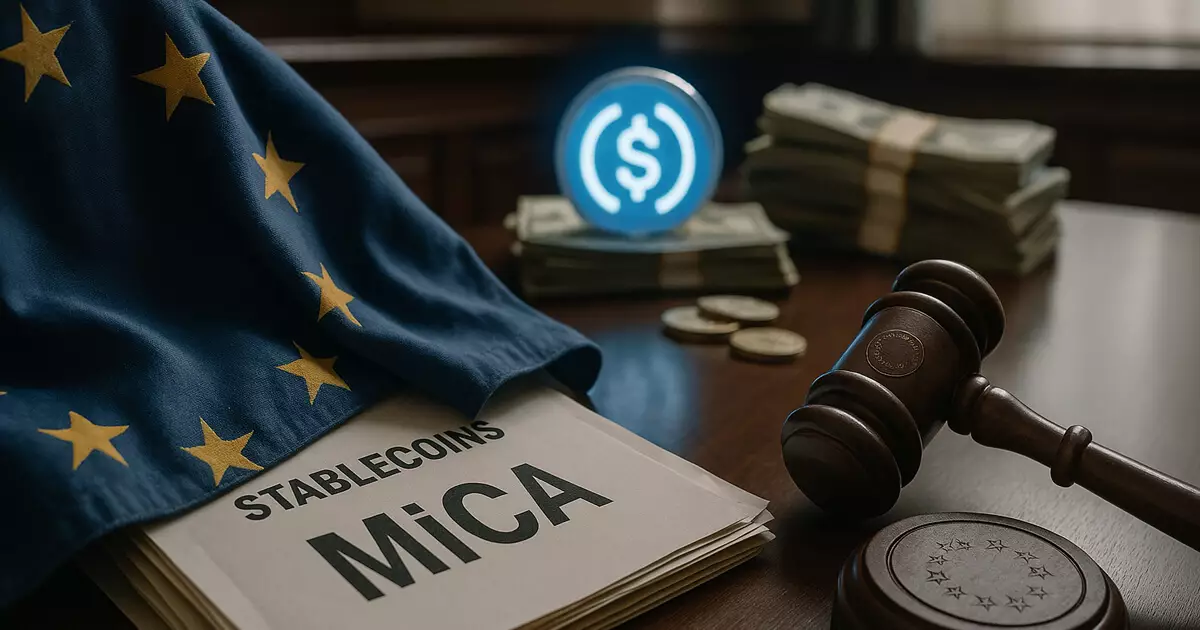The European Union’s Markets in Crypto Assets (MiCA) regulation was launched with the promising intent of establishing governance and safety in the tumultuous crypto landscape. Yet, what is likely to ensue is a significant contradiction: an enhanced, enduring dominance of the U.S. dollar over global financial rails. While superficially MiCA seems geared towards fostering innovation within Europe, it simultaneously lays down the groundwork for restricting euro-backed stablecoins—a move that effectively sidelines Europe in the ongoing race for global financial relevance. This strategic myopia could very well backfire, leaving Europe to watch as the dollar solidifies its grip on the international stage.
Stablecoins: The Digital Currency Game-Changer
Stablecoins have emerged as vital instruments in the global economy, facilitating rapid, transparent, and borderless financial transactions. Currently, a staggering 99% of the stablecoin market operates on the U.S. dollar, a proportion that reflects the dollar’s supremacy rather than a healthy market competition. MiCA’s overly restrictive regulations act as a blockade for euro-pegged stablecoins, undermining Europe’s chances of challenging this status quo. Imposing regulatory hurdles makes it nearly impossible for euro-centered innovations to flourish, creating a facade of protection while reinforcing the dollar’s existing monopoly.
In a world that increasingly relies on digital transactions, the significance of stablecoins cannot be overstated. Europe’s failure to recognize this is more than merely a strategic blunder; it is an acknowledgment of a deep-rooted disconnect with current financial dynamics. Instead of spurring creative euro-backed stablecoin solutions, MiCA drives potential innovation underground, finding refuge in jurisdictions that embrace the new financial frontier.
The Illusion of a Euro CBDC
Proponents of a digital euro, amidst the rise of Central Bank Digital Currencies (CBDCs), believe this innovative mechanism will elevate the euro’s position in global markets. However, this belief is as misguided as it is naive. History has shown that government-run initiatives struggle to replicate the speed and ingenuity of the private sector, which is critical for adaptation in the fast-evolving world of cryptocurrency.
By pushing for a euro CBDC, the EU may be misreading market signals while creating a framework that emphasizes control over freedom. Concerns about privacy infringement, government surveillance, and the potential erosion of consumer autonomy loom large, turning potential euro advocates into skeptics. The dream of a euro CBDC may ultimately backfire if governmental overreach alienates the very user base it aims to attract.
The U.S. Approach: Innovation Over Regulation
In stark contrast to Europe, the United States has noticed this dynamic. By avoiding the temptation to impose a federal CBDC and encouraging the growth of private stablecoins, American regulators show a clear understanding of the market-driven imperative that dictates success in the new financial ecosystem. This facilitation of innovation positions the U.S. as a globally competitive leader rather than a passive spectator.
While MiCA implements stringent measures under the guise of protecting the financial system, it inadvertently locks Europe into an economic bubble of its own making. By squashing the potential for euro-stablecoins, Europe fortifies the existing benefits enjoyed by USD-linked stablecoins and diminishes the opportunity for a competitive monetary alternative.
Geopolitical Implications of Regulatory Overreach
The ramifications of Europe’s regulatory missteps extend beyond mere economic strategies; they threaten to reshape geopolitical landscapes. The stifling of euro-stablecoins is not just about euro’s market share but also concerns the geopolitical power dynamics that play out globally. As European policymakers clumsily navigate a landscape of evolving financial structures, they might inadvertently cede influence in favor of an unchallenged U.S. dollar, which remains under the shadow of their regulations.
As globalization pushes forward, jurisdictions that embrace innovative crypto solutions are set to capitalize on an influx of capital and talent. Europe’s overly cautious approach could risk relegating it to a mere observer in the next chapter of financial infrastructure. If Europe aspires for a meaningful place in the global monetary arena, sensibility must temper its regulatory zeal. The future of currency will be shaped not by constrictions but by those who dare to innovate and adjust to market realities. Unfortunately, with MiCA, Europe may have inadvertently laid the groundwork for the strongest ally the U.S. dollar has ever had.

